DERBY CATHEDRAL QUARTER TRAILS - SADLER GATE
DERBY CATHEDRAL QUARTER – 3 SADLER GATE
Stylish, independent shops, great places to eat and drink, valued professional services and impressive historical landmarks. Derby’s Cathedral Quarter has it all.
Looking down Sadler Gate

Sadler Gate takes its name from leather workers, not only saddlers but bags, boots and shoes. ‘Gate’ is from the Norse word ‘geata’, which meant street in their language – street of the leather workers.
The street, unlike Iron Gate, has not been widened and is now virtually traffic-free. It probably originated as a route to Wardwick and Ashbourne Road and beyond, when the marketplace began its development in c1100. Sadler Gate is much older than it appears on casual examination. The fronts of the buildings have been modernised to keep up with fashion giving the viewer a false impression.
The rears of the buildings have been left untouched. A walk along the various yards soon reveals that many of the properties date back to the 17th century. In particular, George Yard, a long narrow thoroughfare that runs parallel to Sadler Gate. Exposes many of the secrets as to the age of the properties.
Iron Gate and Sadler Gate Corner
Iron Gate and Sadler Gate corner, used to be something of an accident ‘black spot.’ It was the main road in medieval times. But no longer do coaches try to turn the corner at breakneck speed.
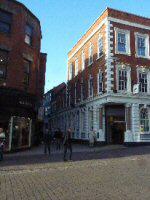
The house on the top corner of Sadler Gate was probably built by Roger Morledge. In about 1695, for the occupation of Alderman Joshua Smith. It later became William Bemrose’s shop, which in 1840 employed a staff of twelve at his printing and stationery business. The business remained in the same location until 1903. However, in later years the premises only housed the bookshop and financial side of the operation.
The arrival of the railways led to the expansion of many existing Derby businesses. Bemrose moved part of his business to Wellington Street, to be near the railway station. The award of the contract to print Midland Railway timetables and stationery saw a dramatic increase in trade. By 1855 the number of workers had increased to 57 and in 1871 to 228. The organization continued to grow into the huge Bemrose Corporation, which employed many thousands of workers.
The Bell Hotel
John Campion acquired the freehold in 1780. During the floods of 1842, the nine-year-old grandson of John Campion II was ‘launched in a wash-tub in the cellars.’ The purpose was to save some vintage bottles of wine placed there by his great-grandfather!
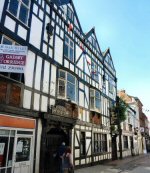
The Bell was a favourite watering hole for local politicians. Some of them tried to bribe the local electorate to vote for them by providing free drinks on Polling Day. Sir Henry Harpur in his quest to get elected even had a list of 42 public houses. Where voters benefited from free beer at election time. Those who did not have the right to vote tended to riot. Disappointed both at missing out on the ballot and also the beer!
A new front to the hotel was added by Ford and Weston as part of a decorative refurbishment in 1929. Black and white mock Tudor timbering was used and rescued from other local sites. A total restoration of this beautiful old building began in 2014. It is one of the few remaining privately owned traditional public houses in Derby. According to legend, it is said to be haunted and has been featured on Sky TV’s ‘Most Haunted.’ Regular ghost walks guided by Richard and Ed Felix start and finish at The Old Bell Hotel.
Blacksmith’s Yard
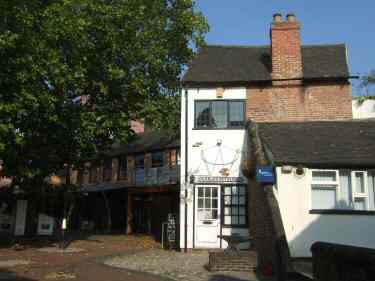
This is a particularly attractive courtyard off Sadler Gate. As the name implies it was a blacksmith’s yard where horses were once shod. However, it has been used for many other purposes and was known as Palfree’s Yard. Following its occupation by Samuel Palfree in the late 1800s. His granddaughter, Barbara Mary Palfree, a veterinary surgeon, had an animal hospital there until 1979. The yard was then redeveloped by David Adams a local builder. A modified version of a 15th-century merchant’s house was rebuilt in the yard. This had been found behind the former Assembly Rooms when the new building was under construction.
Sadler Gate Bridge Sign
It may seem a little strange to the visitor walking down Sadler Gate. To see a sign at the bottom of the street, above a shop indicating ‘Sadler Gate Bridge’. The bridge over the Markeaton Brook, rebuilt by William Strutt in 1786 is now covered. This followed the culverting of the brook in the late 1800s. The culverting enabled a new street, called the Strand to be formed. Originally the bridge gave access across Markeaton Brook to Cheapside and beyond. It was not demolished when the road was formed. And in 1976, it was revealed to the light of day by workmen carrying out road repairs.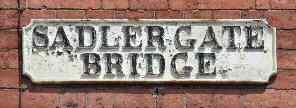
The area became known as Sadler Gate Bridge and the nameplate still exists on the first building in Sadler Gate.
Bass Statue
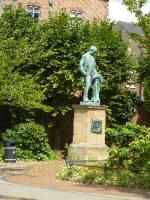
The Library and Museum were built in 1876-1879 to a competition-winning design by R K Freeman of Bolton. It is of Gothic design with a Franco-Flemish tower and Arts-and-Crafts detailing. Particularly admired is a wrought iron by Edwin Haslam around a frescoed gallery. The foundation stone was laid by Michael Thomas Bass, whose statue stands in Museum Square. He was a member of the Burton brewing company. An MP for Derby and a benefactor of the town who paid for the construction of the Library and Museum.
The Museum and Art Gallery was expanded in 1915, and again in 1965. When the Modernist-style building facing the Strand was added.
Wardwick
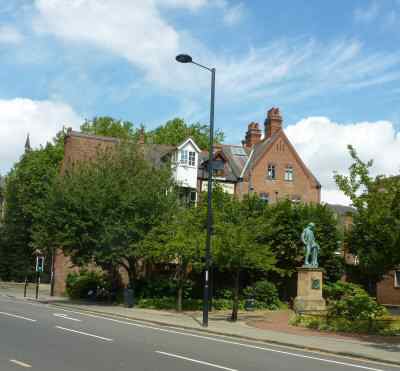
Although the spelling has changed, it is one of Derby’s oldest street names and is recorded in 1085 as Walwick Strete, originally thought to be named after Walda’s Dairy Farm. It was close to the Wardwick where the Mercians first established a village settlement quite distinct and apart from the later Saxon settlement. A small church dedicated to St Werburgh was built around 700AD, but it was sited too close to Markeaton Brook and its foundations eventually became unsafe due to flooding.
The road was widened in 1914. As a result of the demolition, three large houses on the north side of the Wardwick were pulled down and a garden was created by the museum. An extension of which, in 1984, was used to create Museum Square. The iron railings and gates to the garden were re-erected in front of the park facing Nightingale Road.
At roughly the same time that the road was widened, the Museum and Art Gallery were expanded.
Jacobean House

Acclaimed as the finest Jacobean House in Derby, it was most probably built in 1611. Once much larger, having five gables, until in 1855, it was sympathetically reduced in size by architect John Price, to make way for Becket Street. It is still a magnificent decorative building, despite being much diminished in size.
It was for many years the home of the Gisborne family. Built of red brick it was the first brick building to be built in Derby and the grounds extended to two acres. The Heathcote and Jessop families also used it as a townhouse. In recent years it has served various commercial purposes including an estate agent’s office and café bar. The ground floor windows were lowered in 1960.
Library
Before the Public Libraries Act of 1850 was passed, the libraries that were in existence in Derby were generally operated by booksellers and relied on a subscription payment by members. Derby Borough Council did not immediately take advantage of the powers conferred by the new Act.
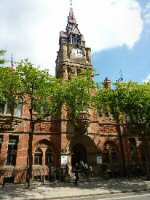
However, in 1878, the Duke of Devonshire donated a collection of books and papers to the Borough, and a year later in a building donated by Michael Thomas Bass, the Derby Free Library and Museum was opened. Apart from the Devonshire Collection, books from other sources were made available and twenty years later the supply numbered almost 20,000, with over 11.000 in the reference books collection.
In 1914, the curator’s house alongside the library was demolished to make way for an extension to be built, to house the recently acquired Bemrose Library. A further extension was completed in 1965, to create a new wing for the Museum and Art Gallery. The library has been moved to the Council House.
Derby Mechanics’ Institute
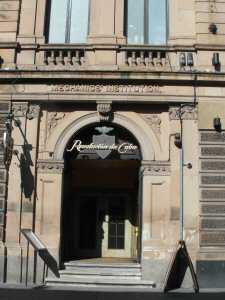
The institute was founded by Joseph Strutt in 1825. It was open from early in the morning until ten at night. There were classes for reading, writing, arithmetic, drawing, music, French and chemistry for adults. A class also met weekly to discuss literary and scientific subjects. The library contained nearly 6,000 volumes and newspapers and periodicals were provided.
Following the death of Lord Belper (title awarded to the Strutt family) in 1880, very few lectures were held and the institute gradually wound down. During its lifetime the Mechanics’ Institute had several famous visitors including, Charles Dickens the author and actor and Franz Liszt, the Hungarian-born pianist and composer.
Flood Marker

An iron plaque is fixed to the front of the Wardwick Tavern that marks the level the floodwaters reached on 1 April 1842; subsequent rises in the level of the street reduce the true impact of the sign. The flood was caused by Markeaton Brook bursting its banks in the days when it flowed on the surface through the town centre. This was exceeded by a similar flood on 22 May 1932, when the brook burst its culvert, causing considerable loss of stock to businesses in the vicinity that used their cellars for storage.
Wardwick Tavern
The Wardwick Tavern is a well-proportioned three-storey inn, built in 1708 for the Alsop family, although parts of an earlier stone building remain. After the Alsops sold the pub, it was purchased by the Lowes’, a well-known brewing family, who built a brewery at the rear. This was considerably enlarged by the Alton family when they came into ownership.
In the 1930s the brewery buildings were demolished to make way for a Telephone Exchange, which itself was replaced 40 years later. The remaining premises were used until the late 1960s as brewery offices when Allied Breweries opened their redundant offices as a pub.
